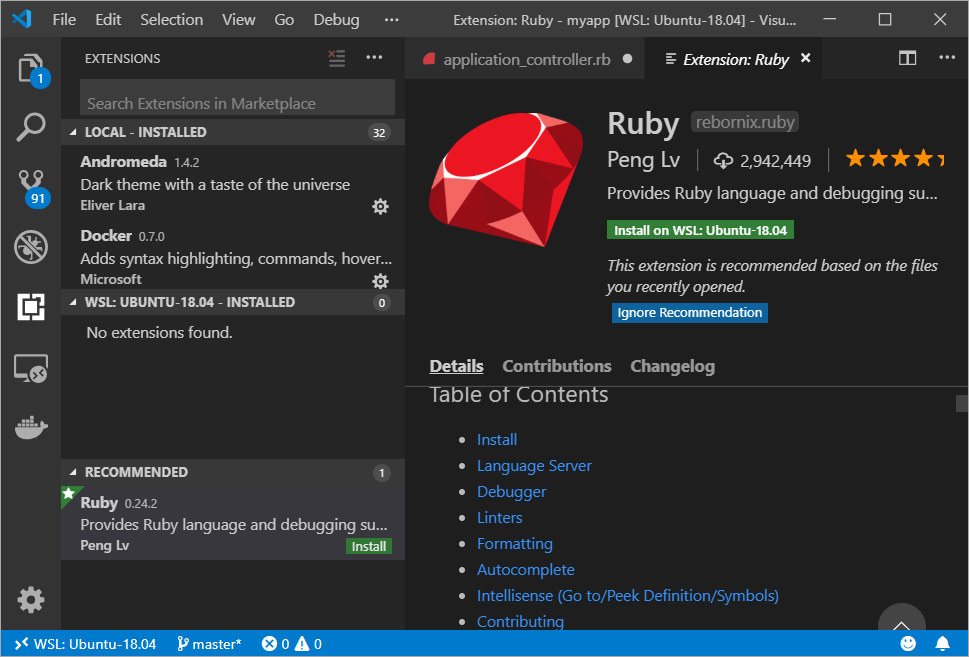

- RUBY DOWNLOAD LINUX INSTALL
- RUBY DOWNLOAD LINUX UPDATE
- RUBY DOWNLOAD LINUX FULL
- RUBY DOWNLOAD LINUX WINDOWS 10
- RUBY DOWNLOAD LINUX PASSWORD
RUBY DOWNLOAD LINUX PASSWORD
Follow the installer steps and note down the username and password used while configuring the installation.
RUBY DOWNLOAD LINUX FULL
This is the full installer that comes with PGAdmin4. Download the installer certified by EnterpriseDB for all supported PostgreSQL versions.
RUBY DOWNLOAD LINUX WINDOWS 10
For, Windows 10 64-bit version, use the highlighted version. You can check the installed rails version as below: $ rails -vĭownload the latest version of PostgreSQL from the as recommended in Official PostgreSQL site. Run this to make the Rails executable available: $ rbenv rehash
RUBY DOWNLOAD LINUX INSTALL
Next, install rails: $ gem install rails -v 5.2.1 We’ll install the current latest version ofįirst, let’s install NodeJS runtime from the official repository that allows us to use Coffeescript and the Asset pipeline in Rails which combines and minifies your javascript to provide a faster production environment. $ echo 'export PATH="$HOME/.rbenv/plugins/ruby-build/bin:$PATH"' > ~/.bashrcīundler install, run the below command: $ rbenv rehash $ echo 'eval "$(rbenv init -)"' > ~/.bashrc $ echo 'export PATH="$HOME/.rbenv/bin:$PATH"' > ~/.bashrc Install Ruby using ‘rubyenv’ with the following commands: $ cd Note : Some of dependencies for postgresql are not mentioned on the gorails blog as it is using mysql. The pre-reqs are required to get Ruby and PostgreSQL installed. If the terminal prompts for confirmation, just press ‘y’.
RUBY DOWNLOAD LINUX UPDATE
Run the following commands in Bash (Remove $ sign as this is part of the prompt at the terminal): $ sudo apt-get update $ sudo apt-get install git-core curl zlib1g-dev build-essential libssl-dev libreadline-dev libyaml-dev libsqlite3-dev sqlite3 libxml2-dev libxslt1-dev libcurl4-openssl-dev python-software-properties libffi-dev postgresql-client-common postgresql-client libpq-dev We’re currently working with Ruby 2.5.3 but this may change in future. Then Turn of the Windows feature for Linux subsystem and follow the installation steps again.įirst, we need to install some dependencies for Ruby environment.

Open command prompt (not bash): lxrun /uninstall /full If you face any issues and need to uninstall again,

Once the installation is completed you’ll be able to search for Bash on Ubuntu on Windows in your start menu. The user must be a sudoer to use system commands at the root level. Setup the username and password for the Linux subsystem. You can also use the command as shown below to download and install from Microsoft Store: Launch the downloaded version from Windows Store and install it. Or you can download and install from Windows Store here for Ubuntu 16.04 LTS version.

Search for Bash in your start menu and follow the installation instructions to get the Ubuntu subsystem installed on Windows 10 which will be downloaded from the Windows Store. Reboot your machine once the installation completes. This only works on 64-bit installations of Windows. Your feedback is most welcome.We’re going to use Bash on Ubuntu on Windows as it allows you to run Linux on your Windows machine. We hope you will find it quite a breeze installing it on your system. # rvm use 2.7.1 -defaultĪnd that’s how you install Ruby on CentOS 8 and RHEL 8. To make the above version the default version for Ruby, run the command. $ ruby -versionĪs seen from the output, the version of Ruby has changed to reflect the latest version which was installed by the RVM manager. Once the installation is complete, verify the version of Ruby. This would be a perfect time to take a coffee break as the rvm installs Ruby 2.7.1. To install Ruby using the RVM manager run the command. # rvm list knownīy the time of writing this guide, the latest version of Ruby is 2.7.1. Once you are done with the installation, you can now check the various versions of Ruby that are available for download using the command. Next, update the system environment variables by executing the command. Therefore, once the installation is done, add the regular user to the rvm group as shown. Additionally, you get a notification that the installer no longer adds users to the rvm group automatically. # curl -sSL | bashĭuring the installation of the RVM script, a new group rvm is created. So, switch from the regular to root user and execute the following curl command. To install rvm, you need to first download the RVM startup script as the root user. Often abbreviated as RVM, Ruby Version Manager is a versatile command-line tool and package manager such as dnf that allows you to install and manage multiple Ruby environments. Install Ruby on CentOS 8 using the RVM Manager $ ruby -versionįrom the output, we can see that we have installed Ruby 2.5.5 on our CentOS 8 system. Upon completion, verify the version of Ruby installed by running the command. $ sudo dnf install gnupg2 curl tarįinally, install Ruby from the Appstream repositories. Next, ensure the below-mentioned packages are installed before going ahead with Ruby.


 0 kommentar(er)
0 kommentar(er)
